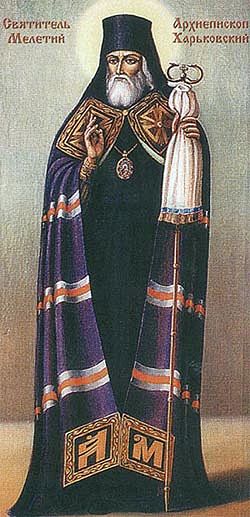Saint Meletius, Archbishop of Kharkov and Akhtyr (in the world Michael Ivanovich Leontovich), was born November 6, 1784 in the village of Stara Stanzhara in the Poltava district.
In 1808 Michael Leontovich successfully completed the Ekaterinoslav Seminary. As the best student, he was sent by Archbishop Platon of Ekaterinoslav to Peterburg, to the Saint Alexander Nevsky Spiritual Academy [in Russia, “spiritual academy” is higher level of religious training beyond seminary]. Finishing the spiritual academy in 1814 with the degree of “magister” [“teacher”], he was appointed adjunct-professor of Greek.
On March 11, 1817 Michael Leontovich was appointed to the office of secretary of the Academy Building committee.
On July 30, 1817 they transferred him to the Kiev Seminary, to serve as inspector and professor of Church History and Greek. When the Kiev Spiritual Academy opened on September 28, 1819, Michael Leontovich became its first inspector.
On February 11, 1820, on the eve of the Feast of Saint Meletius of Antioch, in the cathedral church of the Kiev-Bratsk monastery, he was tonsured into monasticism with the name Meletius. The tonsure was done by Metropolitan Eugene (Bolkhovitnikov) of Kiev. On February 22, 1820 Saint Meletius was ordained deacon by Metropolitan Eugene, and to the priesthood on February 25.
On August 9, 1821 Hieromonk Meletius was appointed rector of the Mogilev Seminary and head of the Kutein Orshansk monastery with the rank of archimandrite. In August 1823 he was made rector of the Pskov Seminary, and on January 24, 1824 Archimandrite Meletius was appointed rector of the Kiev Spiritual Academy.
In October 1826 the Holy Synod decided to appoint Archimandrite Meletius as Bishop of Chigirinsk, a vicar of the Kiev diocese and head of the Zlatoverkh Michaelov monastery. He was elected as bishop on October 19, 1826, and was consecrated on October 21, 1826 at Kiev’s cathedral of Holy Wisdom (Hagia Sophia) .
With a fatherly love the saint looked after young foster-children, raising them in a spirit of devotion to the Church of Christ. The saint particularly cared for the needy, widows and orphans. He often visited the imprisoned and provided them the consolation of religious services in the prison churches. The saint also was also concerned for the spiritual nourishment of the brethren of the Michaelov monastery. With edifying discourses and by personal example he inspired in the monks a spirit of true asceticism. Saint Meletius said, “Humility is the guarding sword, with which we pass over earth and Hades to reach Heaven.”
In April 1828 Saint Meletius was appointed to the Perm cathedral.
Strict with himself, the saint was also strict towards others. To prepare chosen candidates for ordination, Saint Meletius himself wrote the so-called “Ordinand’s Catechism” for them. In August 1831 Saint Meletius was transferred to the See of Irkutsk, with the rank of archbishop.
The saint devoted great attention to the enlightenment of the lesser nations of Russia with the light of the Gospel teaching. He founded churches in the north of Kamchatka, in the northeast parts of the Irkutsk diocese and along the Aldan River, on the tract from Yakutsk to Okhotsk.
He often reviewed his extensive diocese, going to the shores of the Okhotsk and Arctic Seas, to the borders of North America, where the renowned Apostle of Siberia, the priest John Veniaminov, later known as Saint Innocent the Apostle to America (October 6 and March 31) then labored. Journeying through Siberia and along the shores of the Pacific Ocean, Saint Meletius frequently interacted with the native peoples who professed Lamaism. The saint urged them to abandon their errors and he explained the Gospel truths to these pagan peoples: the Tungus, the Buryats, the Kamchadali, and also the inhabitants of the Kurile and Aleutian Islands.
Because of his untiring labors, the saint’s health began to deteriorate, and they transferred him in 1835 to the Slobodsk-Ukrainsk cathedra (afterwards the cathedra of Kharkov and Akhtyr).
Here Saint Meletius devoted his attention to the institutions of spiritual learning, and concerned himself with the life and education of the clergy.
He raised questions about restoring those monasteries and spiritual schools which Empress Catherine II had closed. The saint was also concerned with combating schismatics.
On July 2, 1839 Saint Meletius led the celebrations in the city of Akhtyr for the tenth anniversary of the appearance of the wonderworking Akhtyr Icon of the Mother of God (July 2).
The blessed repose of the saint occurred on the night of February 29, 1840. After Communion, with the words “Now lettest Thou Thy Servant depart in peace,” the saint signed himself with the Sign of the Cross and, after asking forgiveness of everyone, he departed to the Lord.
On March 4, 1840 Saint Meletius was consigned to the earth by the Kursk bishop Heliodorus in a crypt beneath the Church of the Cross at the Protection monastery.
From the first days after his death, believing people firmly trusted in the intercession of Saint Meletius before God, and they received help: healing in sicknesses, comfort in sorrows and deliverance from difficult circumstances. Believers in Kharkov put special trust in Saint Meletius during the terrible days of the “Great War for the Fatherland” (World War II). The saint predicted the impending deliverance of the city from the enemy.
In 1948, with the blessing of His Holiness Patriarch Alexis, the coffin with the relics of Saint Meletius was transferred to the Annunciation cathedral church, where they remain to the present day, providing spiritual recourse and prayerful comfort for believers.

